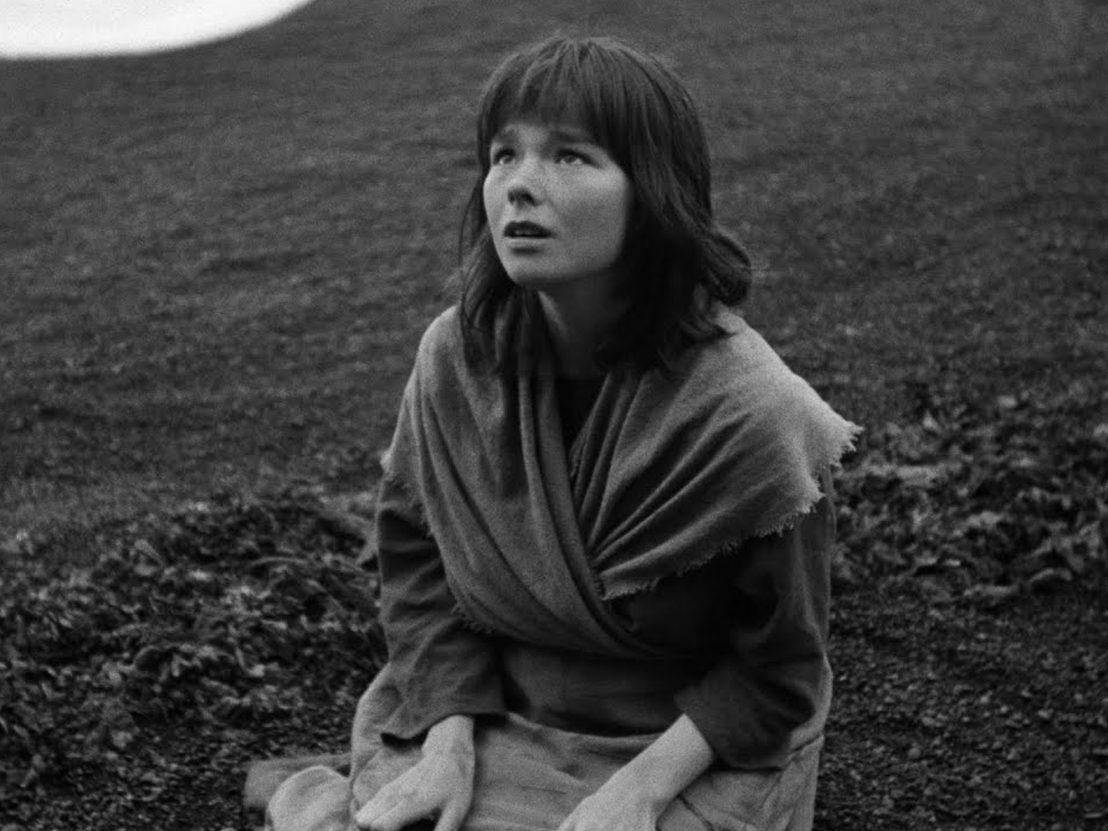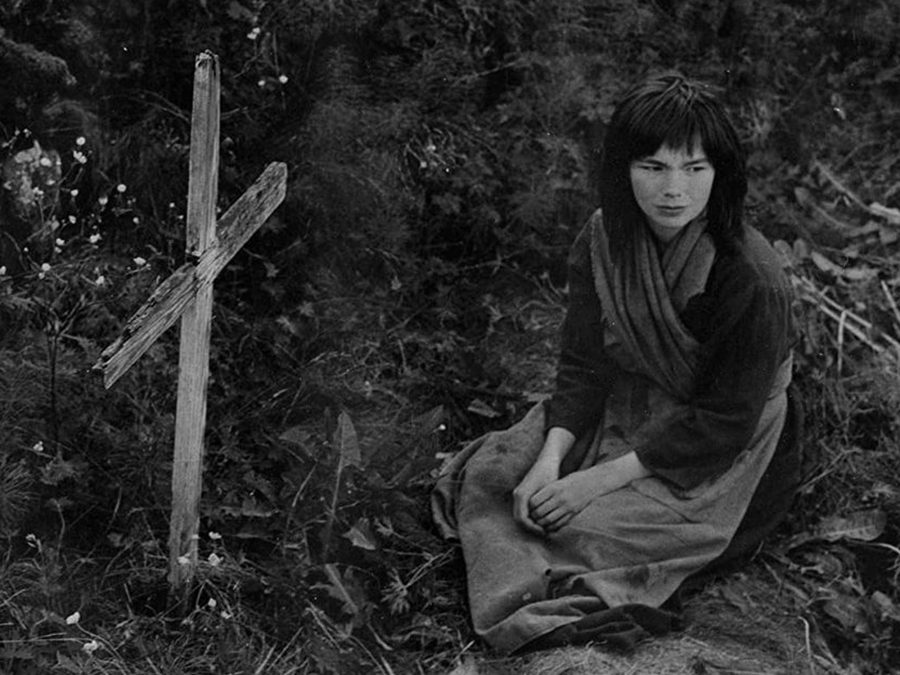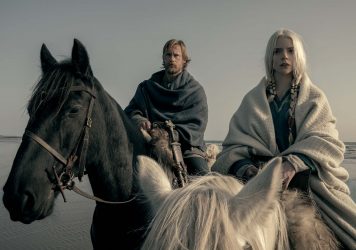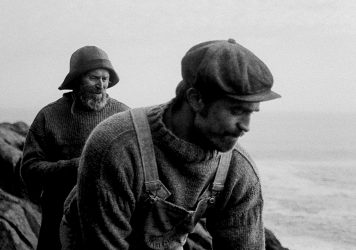
When the trailer for The Northman first dropped last year, one of its many tantalising delights was a brief glimpse of Björk, looming out from the mud, blood, and gloom in a resplendent headdress, whispering something pleasingly ominous. Björk’s performance as The Seeress in Robert Eggers’ Viking epic is something of a coup – it marks the Icelandic icon’s return to the big screen after a seventeen-year absence.
Björk has always been a cinematic pop star, famous for her captivating music videos and bonkers outfits, but her relationship with actual cinema has been limited. In 2000 she was acclaimed for her performance in Lars von Trier’s Dancer in the Dark, but the experience of making the film was famously fraught (von Trier described working with his star as “like dealing with terrorists”; Björk later alleged on-set bullying and sexual harassment).
In the years since, aside from collaborating with ex-husband Matthew Barney on the art film Drawing Restraint Nine, Björk has steered clear of acting. That was until Eggers came calling with a big book of Icelandic sagas, a script co-written with long-time Björk collaborator Sjón, and a very on-brand costume.
Long before she was an international icon, another filmmaker spotted Björk’s on-screen potential. Nietzchka Keene was still a film student at UCLA when she began developing a feature inspired by her love of European folklore and a year spent in Iceland. The result was The Juniper Tree, a revisionist take on a Brothers Grimm story set against an eerie volcanic landscape.
Björk Guðmundsdóttir stars as Margit, a teenager adrift in the Icelandic countryside with her older sister Katla (Bryndis Petra Bragadóttir) after their mother is killed for being a witch. In order to survive, Katla casts a spell to attract a husband, reeling in taciturn widower Johan (Valdimar Örn Flygenring). She and Margit move into the isolated cottage Johan shares with his young son; although Margit forms a bond with the child, he rejects his new stepmother, threatening the stability of this tenuous family.
It’s difficult to watch The Juniper Tree now without seeing it through the lens of its star. When production took place in 1986, Björk was a freckly 21-year-old, pre-international fame, pre-swan dress, pre-The Sugarcubes. By 1990, when the film premiered at Sundance, she was still years away from the release of her breakthrough album Debut. Dressed in burlap with a pixie fringe, Margit is miles away from the avant-garde diva Björk would later become, but even at this early stage, she proves herself a captivating screen presence.

Most of the performances in The Juniper Tree are muted, even a little stilted – Keene captures a still solemnity in her actors which is very Bergman – so it falls to Björk to give the film its heart. In her hands Margit is delicate and sensitive, crackling with volatile magic. Like her sister, Margit has special powers, and Keene draws out Björk’s otherworldliness in eerie sequences in which she is visited by visions of her dead mother, who hovers silently outside her window or opens her shawl to reveal a gaping black hole in her chest.
That latter image wouldn’t be out of place on a Björk album cover, and The Juniper Tree fits perfectly with the cultural myth-making of an artist who has always drawn on Iceland’s landscapes and traditions. The film brims with visuals that would slot seamlessly into one of the musician’s spectacular videos, while eerie lines (“Did you sew his footprints into his coat? Did you sprinkle your blood into his tea?”) could easily be Björk lyrics. Just as von Trier utilised Björk’s musicality by casting her in a musical, so Keene makes the most of her voice by having Margit sing to herself constantly, creepy little folk songs occasionally punctuated by bird-like squawks.
Aside from mutual admiration for Björk, Keene and Robert Eggers share much common ground. Both are nerdily enthusiastic American outsiders drawn to Iceland’s landscapes and folklore, mixing and matching fairy tales, myths, and legends to create a dreamlike stew. In Eggers’ work, humans share the screen with monsters, mermaids, and succubae; in Keene’s too, enchantment is as much a part of the scenery as fjords and volcanoes.
In The Witch, Eggers makes joining a child-eating coven seem like the only sensible response to intractable Puritan misogyny. The women in The Juniper Tree make similarly pragmatic choices, using their magic in order to survive. The stakes are high, as Keene establishes when the sisters encounter the body of a woman face down in a stream. “They’ve stoned her and left for the ravens,” Katla tells Margit matter-of-factly. “We haven’t gone far enough away from home.” In these feminist retellings, the witches are less scary than the thin-skinned men that surround them (unless you’re a small blonde child – in which case, beware).
The Juniper Tree is much simpler visually than the id fantasias of The Witch and The Lighthouse, but Keene shares Egger’s flare for milking maximum atmosphere out of every dollar. Crisp black and white 35mm gives The Juniper Tree a timeless feel, and Keene lets the magical scenery shine, shooting her actors through cascading waterfalls or plumes of steam. In long still wide shots Keene’s actors become tiny figures in these vast vistas. The very first image of Björk’s Margit we see is of her lying against a boulder, gazing outwards, blending into the crags and clouds, dwarfed by her epic surroundings.
In the 35 years since the making of The Juniper Tree, its young star has become an icon and its promising director has passed away. Keene died of cancer in 2004 at the age of 54, leaving behind an unfinished third feature and two unproduced screenplays. Her wonderfully weird first film lives on, however, as a cult curio waiting to be rediscovered by new generations of Björk fans and Iceland enthusiasts. As Björk returns to the big screen in The Northman, now is the perfect moment to go back to where it began and revisit her first screen role. Björk before she was Björk, dressed in burlap, surrounded by wonder, and always brilliantly strange.
Published 15 Apr 2022

Robert Eggers assembles an intrepid team for the epic tale of a wronged Viking prince’s quest for vengeance.

Join us on a longboat to Hell’s gateway with our new issue dedicated to Robert Eggers’ viking revenge saga, The Northman.

By Elena Lazic
Robert Pattinson and Willem Dafoe take a brutal tumble into the abyss in Robert Eggers’ monochrome nightmare.